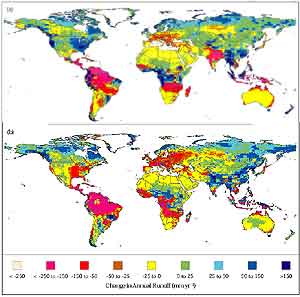3. Effects on and Vulnerability of Natural and Human Systems
3.1. Hydrology and Water Resources

Figure SPM-3: Projected changes in average annual water runoff by
2050, relative to average runoff for 1961-1990, largely follow projected
changes in precipitation. Changes in runoff are calculated with a hydrologic
model using as inputs climate projections from two versions of the Hadley
Centre atmosphere-ocean general circulation model (AOGCM) for a scenario
of 1% per annum increase in effective carbon dioxide concentration in the
atmosphere: (a) HadCM2 ensemble mean and (b) HadCM3. Projected increases
in runoff in high latitudes and southeast Asia, and decreases in central
Asia, the area around the Mediterranean, southern Africa, and Australia
are broadly consistent across the Hadley Centre experiments, and with the
precipitation projections of other AOGCM experiments. For other areas of
the world, changes in precipitation and runoff are scenario- and model-dependent.
|
The effect of climate change on streamflow and groundwater
recharge varies regionally and between climate scenarios, largely following
projected changes in precipitation. A consistent projection across most climate
change scenarios is for increases in annual mean streamflow in high latitudes
and southeast Asia, and decreases in central Asia, the area around the Mediterranean,
southern Africa, and Australia (medium confidence6)
(see Figure SPM-3); the amount of change, however, varies
between scenarios. For other areas, including mid-latitudes, there is no strong
consistency in projections of streamflow, partly because of differences in projected
rainfall and partly because of differences in projected evaporation, which can
offset rainfall increases. The retreat of most glaciers is projected to accelerate,
and many small glaciers may disappear (high confidence6).
In general, the projected changes in average annual runoff are less robust than
impacts based solely on temperature change because precipitation changes vary
more between scenarios. At the catchment scale, the effect of a given change
in climate varies with physical properties and vegetation of catchments, and
may be in addition to land-cover changes. [4.1]
Approximately 1.7 billion people, one-third of the world's population,
presently live in countries that are water-stressed (defined as using more than
20% of their renewable water supply, a commonly used indicator of water stress).
This number is projected to increase to around 5 billion by 2025, depending
on the rate of population growth. The projected climate change could further
decrease the streamflow and groundwater recharge in many of these water-stressed
countries—for example in central Asia, southern Africa, and countries around
the Mediterranean Sea—but may increase it in some others. [4.1;
see also 5.1.1, 5.2.3, 5.3.1,
5.4.1, 5.5.1, 5.6.2,
and 5.8.4 for regional-scale information]
Demand for water is generally increasing due to population growth and economic
development, but is falling in some countries because of increased efficiency
of use. Climate change is unlikely to have a big effect on municipal and industrial
water demands in general, but may substantially affect irrigation withdrawals,
which depend on how increases in evaporation are offset or exaggerated by changes
in precipitation. Higher temperatures, hence higher crop evaporative demand,
mean that the general tendency would be towards an increase in irrigation demands.
[4.1]
Flood magnitude and frequency could increase in many regions as a consequence
of increased frequency of heavy precipitation events, which can increase runoff
in most areas as well as groundwater recharge in some floodplains. Land-use
change could exacerbate such events. Streamflow during seasonal low flow periods
would decrease in many areas due to greater evaporation; changes in precipitation
may exacerbate or offset the effects of increased evaporation. The projected
climate change would degrade water quality through higher water temperatures
and increased pollutant load from runoff and overflows of waste facilities.
Quality would be degraded further where flows decrease, but increases in flows
may mitigate to a certain extent some degradations in water quality by increasing
dilution. Where snowfall is currently an important component of the water balance,
a greater proportion of winter precipitation may fall as rain, and this can
result in a more intense peak streamflow which in addition would move from spring
to winter. [4.1]
The greatest vulnerabilities are likely to be in unmanaged water systems and
systems that are currently stressed or poorly and unsustainably managed due
to policies that discourage efficient water use and protection of water quality,
inadequate watershed management, failure to manage variable water supply and
demand, or lack of sound professional guidance. In unmanaged systems there are
few or no structures in place to buffer the effects of hydrologic variability
on water quality and supply. In unsustainably managed systems, water and land
uses can add stresses that heighten vulnerability to climate change. [4.1]
Water resource management techniques, particularly hose of integrated water
resource management, can be applied to adapt to hydrologic effects of climate
change, and to additional uncertainty, so as to lessen vulnerabilities. Currently,
supply-side approaches (e.g., increasing flood defenses, building weirs, utilizing
water storage areas, including natural systems, improving infrastructure for
water collection and distribution) are more widely used than demand-side approaches
(which alter the exposure to stress); the latter is the focus of increasing
attention. However, the capacity to implement effective management responses
is unevenly distributed around the world and is low in many transition and developing
countries. [4.1]
|